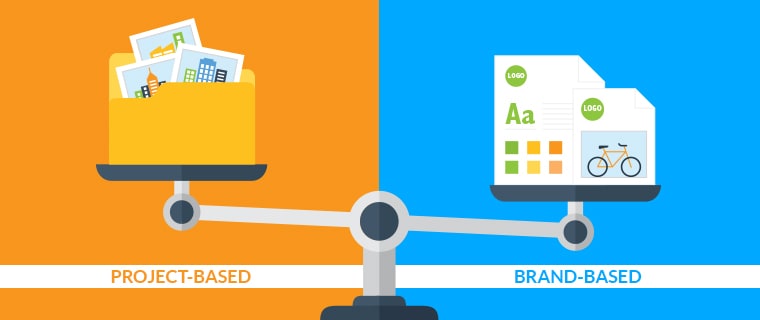The Difference Between Project and Brand Based DAM: Which is Right for You?
Apr 25, 2017

As Digital Asset Management (DAM) solutions continue to become more focused on individual verticals, organizations are giving more consideration to which DAM option fits them best. According to our research, nearly half of companies who do not have DAM in place are in the process of evaluating solutions, or they plan to be soon. But how do you find out which DAM solutions will best meet your organization’s needs?
Among the myriad considerations that go into evaluating DAM —such as project scope, budget, cloud or on-premise hosting—one important factor that might be overlooked is how DAM solutions are used every day. Knowing your potential users, and how they work with a DAM, can be the difference between a successful DAM adoption and a flop.
For the most part, solutions can be divided between project or brand-based DAMs. Project-based DAMs are built to store, organize, and connect digital assets to specific projects and/or properties. Brand-based DAM solutions cater to CPG, retail, and eCommerce verticals and are product, advertising, and consumer facing. They organize and centralize digital assets around brands or products using custom tags and batch keywords.
How assets are organized is much more than a subtle difference, especially for project-focused business—like architecture, construction, engineering, and real estate firms—that may have different search or organization methods than other industries.
When choosing between a project- or brand-based DAM solution, here are some of the differences you should consider and how they can affect your DAM experience.
Integration
Depending on whether a DAM is project- or property-based, integration with other technologies can vary. For example, project-based DAMs will integrate with ERP and CRM solutions, delivering important project and customer information to your visual assets and files. Brand-based solutions, on the other hand, focus more on integration with consumer-facing technologies, often connecting with Social Media or Content Management platforms.
If integration is important, be sure to check which solutions your DAM can connect to when considering your options. Connecting your DAM to the solutions you use most can often streamline your workflow and can make DAM the visual hub of your tech stack.
Image Search and Management
Search and file management are two important aspects of a satisfying DAM experience. The way a business organizes and searches for assets depends on how employees view and access their work. Project-based architecture or real estate companies may find it intuitive to search and tag assets by location, project manager, or reference number. For brand- or product-based companies, these search criteria may not apply. These companies would most likely prefer a more customizable method of tagging and categorizing.
Since project- and brand-based DAM solutions have different organization methods and options for search, it’s important to be aware of how your firm handles these tasks. Then look for a DAM solution that will be an intuitive fit for the way your company works.
Sales and Marketing Material Development
Product-based companies and project-based firms take different approaches when it comes to marketing and promoting their offerings and engaging with their customers. As a result, the way they use their DAMs, and the assets within those DAMs, is different, too.
For example, in a brand-based company, the head office may be rolling out a new brand identity or releasing new packaging guidelines for a specific product. This needs to be shared and distributed to the global supply chain of creatives, project managers, and manufactures to ensure consistency across the brand. Brand organizations put a premium on control and distribution to complex supply chains. And this is what brand-based DAMs do best: they enhance and support these workflows by tracking edits, proofs, and control of products.
In project-based companies, digital assets (i.e. project images and videos) are often used to create marketing materials for professional services including brochures, presentations, and corporate marketing collateral. They don’t do packaging or much traditional advertising. Features in project-based DAMs, like OpenAsset, enhance workflows for putting together presentations or creating a sales brochure to support the types of content being produced by corporate marketing departments in architecture, real estate, construction, and engineering firms.
Support and On-Boarding
As DAM vendors become more industry focused and further tailor their solutions to the needs of certain types of companies, the better your experience is going to be when you select a DAM that’s designed specifically for the way your business operates. This includes the support that comes with your DAM purchase, beginning with the on-boarding process.
In other words, if you are a project-based firm and you select a project-based DAM, you can expect your vendor to understand your asset management needs and have a good idea of how you want to set up your system. Based on the vendor’s past experience with companies like yours, your DAM provider should be able to give you solid advice on what works well, and what doesn’t, when it comes to your asset organization method and how to use the tool on a daily basis.
So, when you are considering a new solution, make sure to ask which industries the vendor specifically caters to or serves. By choosing a specialized DAM vendor, you can expect a smoother transition to your new technology, a better ongoing fit, and greater overall satisfaction with your new DAM solution.
As the number-one project-based DAM on the market, OpenAsset currently supports more than 400,000 projects for leading firms. See some of the companies that use OpenAsset or reach out to learn more about the differences between project-based and brand-based DAM solutions.





